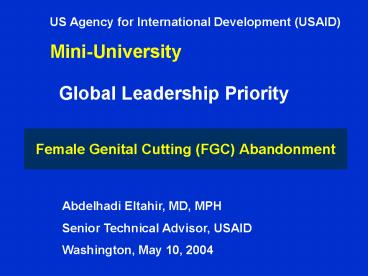Female Genital Cutting FGC Abandonment - PowerPoint PPT Presentation
1 / 18
Title:
Female Genital Cutting FGC Abandonment
Description:
'FGC is a harmful, traditional practice that violates the ... Potential increased need for blood transfusions. Presence of genital ulcers and dermoid cysts ... – PowerPoint PPT presentation
Number of Views:181
Avg rating:3.0/5.0
Title: Female Genital Cutting FGC Abandonment
1
Female Genital Cutting (FGC) Abandonment
US Agency for International Development
(USAID) Mini-University
Global Leadership Priority
Abdelhadi Eltahir, MD, MPH Senior Technical
Advisor, USAID Washington, May 10, 2004
2
Definitions
FGC is a harmful, traditional practice that
violates the health and human rights of women and
hinders development (USAID FGC Policy)
FGM is a variety of operations involving partial
or total removal of the female external genital
organs WHO
3
Regions where FGC/FGM reported
4
FGC Prevalence among women 15-49 yrs
5
FGC is a Multi-Sector Issue
Protecting human rights is a major component for
sustaining democracy, African women have decided
that FGC is a human rights issue and its
elimination efforts will be more successful if it
is embarked on from a human rights perspective.
- DEVELOPMENT
- POLITICAL
- GENDER
- RELIGIOUS
- HUMAN RIGHTS
- HEALTH
6
Current Interventions and Approaches
- Health Risk Approach
- Alternative Rite of Passage
- Medicalization
- Conversion Strategy
- Law Enforcement
- Social mobilization
- Positive Deviance
7
Legislations Against FGC in African countries
- Guinea - 1965
- Ghana - 1994
- Burkina Faso - 1995
- Djibouti 1995
- Egypt Decree 1997
- Ivory Coast - 1997
- Tanzania - 1998
- Togo - 1998
- Senegal 1999
- Kenya 2001
- Benin 2003
- Chad - 2003
8
How FGC activities fit within health strategies
Advance and Support voluntary Family Planning and
Reproductive Health Programs
- FGC Abandonment is integral to FP/RH programs
- Will be incorporated in policy dialogue, advocacy
and services delivery. - Lessons learned, best practices and knowledge
generated by the FGC GLP will be widely
disseminated for implementation of effective and
sustainable FP/RH programs
9
How FGC activities fit within health strategies
(Contd)
Reduction in deaths and adverse health outcomes
to women as a result of childbirth
- FGC long-term complications include increased
risk during child birth. - FGC abandonment activities (e.g. training of
health care provider) can reduce the incidence of
complications leading to improved maternal health.
10
How FGC activities fit within health strategies
(Contd)
Improvement of infant and child health and
nutrition and reduction in infant and child
mortality
- Abandoning FGC among girls, an important step
towards improving child health and reducing
infant and child mortality. - FGC abandonment reduces the risk of birth
complications among affected women thereby
decreasing the risk of infant and neonatal
mortality.
11
How FGC activities fit within health strategies
(Contd)
- Reduction of HIV/AIDS transmission
- The practice of FGC poses significant risk for
HIV transmission - Repeated use of cutting instruments
- Increased trauma during sexual intercourse
- Potential increased need for blood transfusions
- Presence of genital ulcers and dermoid cysts
12
Accomplishments and Results
- Donors Working Group on FGC
- Standardized FGC Indicators
- Generate Donors Matrix
- Improved Information-Sharing through list-serve
- Measure DHS contribution
- FGC added to DHS Stat compiler
13
Accomplishments and Results
- Zero Tolerance International Day
- 2-day events in February 2004
- Promotion of Legislations against FGC
- USAID continues to encourage governments to
enact anti-FGC laws and policies
14
Results (cont.)
Cost Shifting Trend Core to Field Support
USAID/Ethiopia
USAID/Guinea
USAID/Egypt
FS/Core ? 100
FS/Core ? 50
FS/Core ? 75
15
Changes in Intention not to Cut Daughters in
Future
Accomplishments and Results
16
Accomplishments and Results
Percentage of clients in favor of abandoning FGC
(N364)
- PRIME Mali
0.7
60.4
0.6
0.5
0.4
24.0
0.3
0.2
0.1
0
February 2002
June 2003
17
Accomplishments and Results
Percentage of clients who intend to have FGC
performed on their daughters (N367)
- PRIME Mali
0.8
68.0
0.7
0.6
42.4
0.5
0.4
0.3
0.2
0.1
0
February 2002
June 2003
18
Accomplishments and Results (cont.)
- TOSTAN Evaluation in Senegal reported a
significant increase in knowledge of
contraceptive methods. - Women 63 at baseline 99 at end-line
- Men 69 at baseline 98 at end-line

